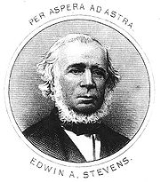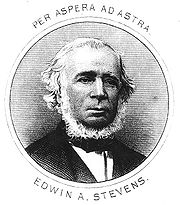
Edwin A. Stevens
Encyclopedia

United States
The United States of America is a federal constitutional republic comprising fifty states and a federal district...
engineer, inventor, and entrepreneur who left a bequest that was used to establish the Stevens Institute of Technology
Stevens Institute of Technology
Stevens Institute of Technology is a technological university located on a campus in Hoboken, New Jersey, USA – founded in 1870 with an 1868 bequest from Edwin A. Stevens. It is known for its engineering, science, and technological management curricula.The institute has produced leading...
.
Early life and family
Stevens was born at Castle Point, Hoboken, New JerseyHoboken, New Jersey
Hoboken is a city in Hudson County, New Jersey, United States. As of the 2010 United States Census, the city's population was 50,005. The city is part of the New York metropolitan area and contains Hoboken Terminal, a major transportation hub for the region...
, the son of Colonel John Stevens III
John Stevens (inventor)
Col. John Stevens, III was an American lawyer, engineer and an inventor.-Life and career:Born the son of John Stevens , a prominent New Jersey politician who served as a delegate to the Continental Congress, and Elizabeth Alexander, daughter of New York lawyer and statesman James Alexander. His...
(1749-1838) and his wife Rachel Cox (1761-1839). He was the sixth of eleven children, and among his older brothers were John Cox Stevens
John Cox Stevens
John Cox Stevens is best known for founding and serving as the first Commodore of the New York Yacht Club as well as being a member of the America syndicate which won the first America's Cup trophy in 1851....
and Robert Livingston Stevens. In 1836 he married Mary Barton Picton, daughter of Rev. Thomas Picton of Princeton, New Jersey
Princeton, New Jersey
Princeton is a community located in Mercer County, New Jersey, United States. It is best known as the location of Princeton University, which has been sited in the community since 1756...
. They had a daughter, Mary Picton Stevens (May 19, 1840 –
September 21, 1903), who went on to marry Virginia
Virginia
The Commonwealth of Virginia , is a U.S. state on the Atlantic Coast of the Southern United States. Virginia is nicknamed the "Old Dominion" and sometimes the "Mother of Presidents" after the eight U.S. presidents born there...
politician Muscoe Russell Hunter Garnett
Muscoe Russell Hunter Garnett
Muscoe Russell Hunter Garnett , was a nineteenth century politician and lawyer from Virginia.Garnett was the son of James Mercer Garnett and Maria Garnett. He was the grandson of James M. Garnett and nephew of Robert Mercer Taliaferro Hunter. He was born on his family’s "Elmwood" estate...
and later Edward Parke Custis Lewis
Edward Parke Custis Lewis
Edward Parke Custis Lewis was a Confederate Army colonel, lawyer, legislator, and diplomat who served as United States Minister to Portugal from 1885 to 1889.-Biography:...
, U.S. minister to Portugal
Portugal
Portugal , officially the Portuguese Republic is a country situated in southwestern Europe on the Iberian Peninsula. Portugal is the westernmost country of Europe, and is bordered by the Atlantic Ocean to the West and South and by Spain to the North and East. The Atlantic archipelagos of the...
.
In 1854, after his first wife's death, Stevens married Martha Bayard Dod (May 15, 1831 – April 1, 1899). She was the daughter of Albert Baldwin Dod
Albert Baldwin Dod
Albert Baldwin Dod was an American Presbyterian theologian and professor of mathematics. He was born in Mendham, New Jersey, and after a religious awakening while at college in Princeton, Dod became affiliated with the influential Princeton Theologians...
(1805-1845), professor of mathematics at Princeton University
Princeton University
Princeton University is a private research university located in Princeton, New Jersey, United States. The school is one of the eight universities of the Ivy League, and is one of the nine Colonial Colleges founded before the American Revolution....
, and Caroline Smith Bayard, who was the daughter of Samuel Bayard (1766-1840) and granddaughter of Continental Congress
Continental Congress
The Continental Congress was a convention of delegates called together from the Thirteen Colonies that became the governing body of the United States during the American Revolution....
man John Bubenheim Bayard (1738-1808). With Martha he had six children: John Stevens (b. July 1856), grandfather of Millicent Fenwick
Millicent Fenwick
Millicent Hammond Fenwick was an American fashion editor, politician and diplomat. A four-term Republican member of the United States House of Representatives from New Jersey, she entered politics late in life and was renowned for her energy and colorful enthusiasm...
; Edwin Augustus Stevens Jr.
Edwin Augustus Stevens Jr.
Edwin Augustus Stevens, Jr. was an army officer, marine engineer, and naval architect. He was among the founders of Cox & Stevens in 1905, which became an influential and successful New York design firm....
(b. March 14, 1858); Caroline Bayard Stevens (b. November 21, 1859), who married Archibald Alexander and then H. Otto Wittpenn
H. Otto Wittpenn
Henry Otto Wittpenn was the Mayor of Jersey City, New Jersey from January 1, 1908 to June 16, 1913. He was a member of the New Jersey State Highway Commission and was the president of both the Hoboken Land and Improvement Company and the First National Bank of Hoboken...
; Robert Livingston Stevens (b. August 26, 1864); Charles Albert Stevens (b. December 14, 1865); and Richard Stevens (b. May 1868).
Career
At an early age Stevens was entrusted by his father with the family business affairs, and in 1821 at the age of 26 he assumed full responsibility for the Stevens estate in Hoboken and other properties. Also in 1821, he developed the "Stevens plow," a cast-iron plow with a curved moldboard and replaceable heel piece. The plow was popular among New Jersey farmers. He went on to design many other technological innovations, such as the “twohorse dump wagon” for New York City; the "closed fireroom” system of forced draft for his family's steamboat fleet; and the "vestibule car" for the Camden and Amboy Railroad.Following the death of Colonel Stevens in 1838, Edwin and his brother Robert worked on a commission from the United States government to construct the nation's first ironclad naval vessel. After conducting tests to determine the amount of armor a vessel needed to defend itself against naval guns, the two brothers constructed a huge vessel known as the Stevens Battery
Stevens Battery
The Stevens Battery was an early design for a type of ironclad, proposed for use by the United States Navy before the American Civil War. One full-sized example was begun but never completed due to lack of funding.-Background:...
. Though the craft was never fully completed, it nevertheless laid the groundwork for the modern armored warship. A scaled-down version, the USS Naugatuck
USS Naugatuck (1844)
USRC Naugatuck was a twin-screw ironclad experimental steamer owned by the US Revenue Cutter Service during the American Civil War. She served the U.S. Treasury Department as the USRC E.A. Stevens , a name she retained until sold in 1890...
, saw limited action in the Civil War
American Civil War
The American Civil War was a civil war fought in the United States of America. In response to the election of Abraham Lincoln as President of the United States, 11 southern slave states declared their secession from the United States and formed the Confederate States of America ; the other 25...
. After the war, the Naugatuck and the Battery were sold for scrap.
Stevens was part of the syndicate from the New York Yacht Club
New York Yacht Club
The New York Yacht Club is a private social club and yacht club based in New York City and Newport, Rhode Island. It was founded in 1844 by nine prominent sportsmen. The members have contributed to the sport of yachting and yacht design. The organization has over 3,000 members as of 2011. ...
that built and raced the schooner-yacht America
America (yacht)
The America was a 19th century racing yacht that was the first to win the eponymous international sailing trophy now known as the America's Cup; in 1851 the trophy was known as the Royal Yacht Squadron's "One Hundred Guinea Cup", but was later renamed after the original winning yacht...
. His brother, John Cox Stevens
John Cox Stevens
John Cox Stevens is best known for founding and serving as the first Commodore of the New York Yacht Club as well as being a member of the America syndicate which won the first America's Cup trophy in 1851....
, was the head of the syndicate and the NYYC's first Commodore. Edwin Augustus also served as Commodore of the NYYC, resigning in 1866.
He died in Paris, France. His will left land adjoining his family estate, $150,000 for the erection of a building and $500,000 as an endowment for the establishment of an "institution of learning".
Because of the Stevens family's close ties with engineering, the executors decided this would be an institution devoted to the "mechanical arts".
A building on the Stevens campus now stands as The Edwin A. Stevens Hall
Edwin A. Stevens Hall
Edwin A. Stevens Hall is located in Hoboken, New Jersey. The building was added to the National Register of Historic Places on February 4, 1994. The building was designed by Richard Upjohn and built in 1870. The building was named after Edwin Augustus Stevens and used as the main building for the...
, which houses the school of engineering for the Institute. Also in this building is the renowned "DeBaun Auditorium", which is over 100 years old, and has been refurbished to what it would have looked like when first constructed.

